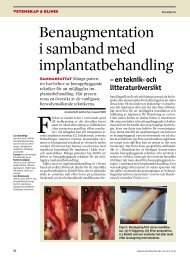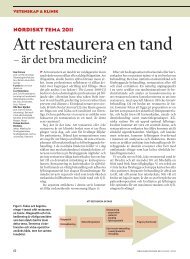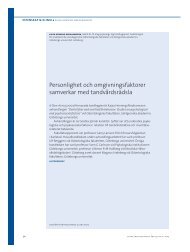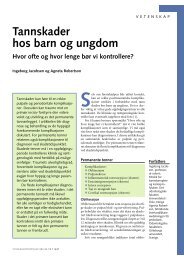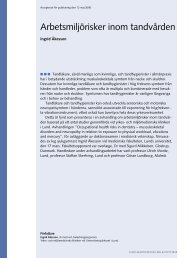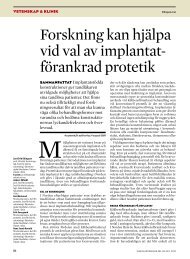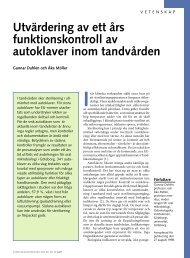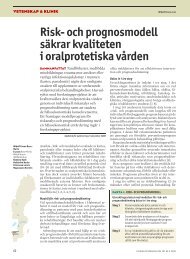Humana papillomvirus och orala infektioner - Tandläkartidningen
Humana papillomvirus och orala infektioner - Tandläkartidningen
Humana papillomvirus och orala infektioner - Tandläkartidningen
Create successful ePaper yourself
Turn your PDF publications into a flip-book with our unique Google optimized e-Paper software.
ler delvis vilket ger ett negativt resultat vid pcr. Den<br />
senaste metoden kallas realtids-pcr <strong>och</strong> betyder också<br />
att man kan bestämma mängden av den gen som<br />
förstärks eller dess mrna. Metoden har använts för<br />
att identifi era integrerat hpv 16-material i prover [82].<br />
Koskinen et al [83] kunde med hjälp av realtids-pcr<br />
identifi era hpv i 16 av 61 biopsier från cancer i mun,<br />
huvud <strong>och</strong> hals. Virusgenom fanns integrerat i 48 procent<br />
av fallen <strong>och</strong> episomalt i 35 procent. I 17 procent av<br />
muncancerbiopsierna fann man båda formerna.<br />
Antalet replikerade viruskopior i muncancervävnaden<br />
är ännu inte helt känt. Studier har visat att endast<br />
en del av cancercellerna är positiva för virus <strong>och</strong> att<br />
virusmängden dessutom är låg i dessa celler. Det skulle<br />
kunna betyda att endast en del av hpv replikeras i cancercellerna<br />
alternativt att cancern inte är av klonalt ursprung.<br />
Koskinen et al fann [83] endast 1–97 viruskopior<br />
per 10 000 <strong>orala</strong> cancerceller. De senaste åren har<br />
man inte bara studerat förekomsten av virusgenom i<br />
cancerceller utan också uttrycket av dess cancergener<br />
för att om möjligt kunna belysa den virala aktiviteten<br />
[84–86]. I cirka hälften av fallen av hpv-dna-positiva<br />
muncancerformer var mrna uttryckt. Detta uttryck<br />
var associerat med normalt p53 i tumören (wild-type)<br />
[86] med nedsatt pRB <strong>och</strong> ett överuttryck av p16 i<br />
tumörerna. Uttrycket av hpv 16 E6/E7 har också associerats<br />
med en specifi k morfologi i cancervävnaden<br />
[87] <strong>och</strong> en nedsatt allelförlust hos 13 av 15 markörer<br />
för kromosomerna 3p, 9p <strong>och</strong> 17p [86].<br />
Både terapeutiska <strong>och</strong> profylaktiska vacciner har<br />
utvecklats mot hpv. En del av dessa vacciner provas<br />
för närvarande i kliniska studier. Om de profylaktiska<br />
vaccinerna visar sig vara effektiva skulle upp till<br />
25 procent av de olika cancerformerna i huvud- <strong>och</strong><br />
halsområdet kunna förebyggas [88].<br />
English summary<br />
Human papillomaviruses and oral infections<br />
Stina Syrjänen<br />
<strong>Tandläkartidningen</strong> 2006; 98 (2): 40–8<br />
Over the past 25 years, interest in human papillomaviruses<br />
(hpv) has increased remarkably, because of their<br />
potential role in pathogenesis of several human malignancies.<br />
Today, 106 hpv types have been identifi ed of<br />
which almost 40 have been detected in oral mucosa.<br />
In 1983, Stina Syrjänen and her group published<br />
the fi rst evidence suggesting that hpv might be involved<br />
in pathogenesis of oral squamous cell carcinoma.<br />
The recognition of morphological similarities<br />
between oral and previously established genital hpv<br />
lesions led to this pioneering proposal. In the recent<br />
meta-analyses of the existing evidence as well as in<br />
several case-control studies, hpv has been confi rmed<br />
as an independent risk factor for oral squamous<br />
cell carcinoma. The evidence indicates that hpv associated<br />
oral cancers form an entity with a better<br />
survival. hpv can also cause benign lesions in oral<br />
mucosa, such as papillomas, condylomas, warts and<br />
focal epithelial hyperplasia (feh).<br />
hpv is also detectable in healthy mucosa of adults<br />
and infants. hpv has been traditionally regarded as a<br />
sexually transmitted disease, but the recent evidence<br />
implicates the existence of other modes of transmission.<br />
It is now apparent that parts of the hpv infections<br />
in newborns are acquired vertically from the<br />
mother during delivery. Of the oncogenic hpv types,<br />
hpv 16 is the most prevalent type in oral carcinoma.<br />
Viral copy numbers in oral cancers are generally low,<br />
suggesting a non-clonal association of the tumor<br />
with hpv. If this is the case, hpv is not needed for<br />
maintenance of the malignant state. A hit and run<br />
theory has been proposed several times to explain the<br />
development of hpv-negative tumors. Of the eight<br />
open reading frames (orf), the early genes and particularly<br />
E6 and E7 are the most important oncogenes<br />
involved in hpv-induced immortalization and<br />
cell transformation. E6 and E7 oncoproteins are able<br />
to interfere with several cellular proteins playing key<br />
role in controlling cell cycle, apoptosis and cellular<br />
differentiation. ”The guardian” of the cell genome,<br />
p53 binds with E6 in the presence of E6AP leading to<br />
the degradation of p53, and similarly E7 binds to retinoblastoma,<br />
pRB. In addition, the hpv E5 protein<br />
has some transforming features. hpv cannot be cultivated<br />
but replication of the virus is dependent on<br />
epithelial differentiation with an unknown mechanism.<br />
Currently, clinical trials are ongoing on prophylactic<br />
and therapeutic vaccines for hpv aiming to<br />
global eradication of cervical cancer. If these vaccinations<br />
are successful, there is a possibility that also up<br />
to 25% of head and neck cancers can be prevented by<br />
these prophylactic hpv vaccines.<br />
Referenser<br />
1. Syrjänen K, Syrjänen S. Papillomavirus infections in human<br />
disease. New York: Wiley; 2000. p. 1–615.<br />
2. zur Hausen H. Papillomaviruses and cancer: from basic studies<br />
to clinical application. Nat Rev Cancer 2002; 2: 342–50.<br />
3. Syrjänen S, Puranen M. Human papillomavirus infections in<br />
children: the potential role of maternal transmission. Crit Rev<br />
Oral Biol Med 2000;11:259–74. Review.<br />
4. Syrjänen S. HPV infections in children. Invited review. Papillomvirus<br />
Report 14:93–110, 2003.<br />
5. Syrjänen S. Human papillomavirus (HPV) in head and neck<br />
cancer. J Clin Virol 2005; 32S: S59–S66.<br />
6. Syrjänen S. Human papillomavirus (HPV) in oral cancer. J Clin<br />
Pathol. In press.<br />
7. Snijders PJ, Steenbergen RD, Meijer CJ, Walboomers JM. Role<br />
of human papillomaviruses in cancer of the respiratory and<br />
upper digestive tract. Clin Dermatol 1997; 15: 415–25.<br />
8. Smith EM, Hoffman HT, Summersgill KS, et al. Human papillomavirus<br />
and risk of oral cancer. Laryngoscope 1998; 108:<br />
1098–103.<br />
9. Herrero R. Human papillomavirus and cancer of the upper<br />
aerodigestive tract. J Natl Cancer Inst Monogr 2003; 31: 47–51<br />
[Chapter 7].<br />
10. Syrjänen K, Syrjänen S, Lamberg M, et al. Morphological<br />
and immunohist<strong>och</strong>emical evidence suggesting human<br />
Orala <strong>infektioner</strong><br />
tandläkartidningen årg 98 nr 2 2006 47



